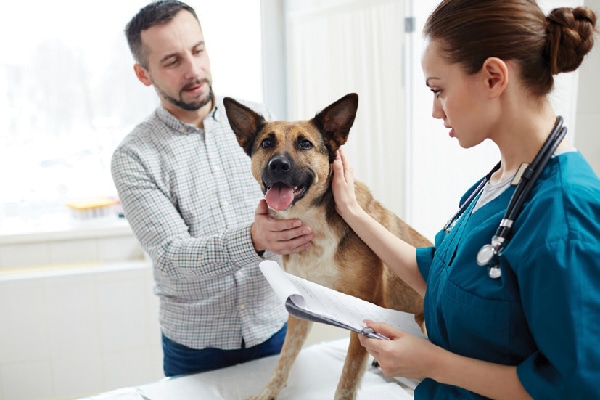The post What to Do for a Dog With Diarrhea by Catherine Ashe appeared first on Dogster. Copying over entire articles infringes on copyright laws. You may not be aware of it, but all of these articles were assigned, contracted and paid for, so they aren’t considered public domain. However, we appreciate that you like the article and would love it if you continued sharing just the first paragraph of an article, then linking out to the rest of the piece on Dogster.com.
Dog diarrhea. Yuck! We’ve all dealt with it. Unfortunately, diarrhea is a common affliction in our canine friends. Wondering what to do for a dog with diarrhea? And when is dog diarrhea an emergency and when can it wait?
The good news is that diarrhea is rarely a true emergency. It is often caused by intestinal parasites, dietary indiscretion or an infection in the intestines. There are some notable exceptions, but most of the time, you can wait for an appointment with your dog’s general practitioner.
Diarrhea is usually a sign that the gastrointestinal tract is working, as food and water are moving through it. Initial symptomatic care is frequently appropriate. There are several ways that you can help ease your pet’s digestive woes.
What to do for a dog with diarrhea at home

What can you do for a dog with diarrhea at home? Photography © Wavetop | iStock / Getty Images Plus.
Wondering what to do for a dog with diarrhea? There are a few homemade dog diarrhea remedies you can try. Switch to a bland, easily digestible diet such as chicken and rice or broth and rice. You can add canned pumpkin (not pumpkin pie mix) (1 to 3 tablespoons) to any food. This might bulk up the diarrhea and help slow down gut motility.
Unlike with vomiting, you do not need to withhold food. Walk your dog frequently to avoid accidents in the house. As gross as it sounds, monitor bowel movements closely so that if a vet visit is necessary, you can answer specific questions.
Things to note include:
- frequency
- if it is a large quantity or small
- whether excessive straining is noted
- whether any foreign objects are noted
- if there are parasites
If diarrhea persists for more than three to five days or is accompanied by other signs like vomiting, loss of appetite or abdominal pain, it’s time to visit your vet. At that time, she will likely conduct a fecal test to check for intestinal parasites. She may then try more specific therapy such as a probiotic, dewormer, veterinary diet and/or an antibiotic.
Go straight to the vet

A dog at a vet check with his human. Photography ©shironosov | Getty Images.
Sometimes, though, the answer to what to do for a dog with diarrhea is bring that dog straight to the vet. So, when IS diarrhea a true emergency? Any time there are copious amounts of blood or your pet exhibits weakness, notable lethargy, vomiting, abdominal pain or ongoing lack of appetite, your canine friend should have a checkup ASAP. There are a few cases in which severe, sudden diarrhea can signal a life-threatening emergency.
More on emergency diarrhea
Acute bloody diarrhea coupled with other signs like vomiting or collapse can indicate severe illness including ingestion of toxins (like blue green algae), anaphylaxis, Addison’s disease, acute hemorrhagic diarrhea syndrome and mesenteric volvulus.
Anaphylaxis is not uncommon in dogs. Generally, this happens in a dog who was previously totally normal, goes outside, develops weakness, vomiting, collapse and diarrhea, often very bloody. This is frequently caused by a bee sting or other insect exposure. Anaphylaxis is an immediate emergency. Do not wait to see if your dog improves, but seek urgent veterinary care.
A similar condition that can be quite serious is acute hemorrhagic diarrhea (AHDS). It may have the same sudden onset of signs. Both require intensive care for a positive outcome.
Addison’s disease, a lack of corticoid production in the body, can also cause vomiting and diarrhea. This tends to be a waxing and waning condition with other signs, as well.
Another, rarer cause of acute onset of severe diarrhea is a condition called mesenteric volvulus. This happens most frequently in German Shepherd Dogs. It occurs when the small intestines become twisted, depriving the gut of blood flow and thus oxygen. It is an immediate emergency.
How diarrhea is treated by an emergency vet
If your dog presents to the emergency clinic with these clinical signs, the veterinarian will work quickly. This will include getting a brief but thorough history (remember those things I said to observe?) that includes your dog’s deworming history, any medications your dog takes, any known toxin exposure and any previous medical problems. She will then place an IV catheter to start fluids, and follow up with testing to determine the root of the problem. Depending on the underlying cause, your veterinarian will recommend treatment.
Fortunately, in most cases, diarrhea is not an emergency and can be managed at home with some simple changes to diet. When in doubt about what to do for a dog with diarrhea, consult with your veterinarian.
Thumbnail: Photography ©Terry J Alcorn | Getty Images.
About the author
Catherine Ashe is a veterinarian, mother and freelance writer residing in Asheville, North Carolina. For nine years, she practiced emergency medicine and is now a relief GP. When not working, she spends time with her family of six, reading, writing and enjoying the Blue Ridge mountains.
Read more about dog health and care on Dogster.com:
The post What to Do for a Dog With Diarrhea by Catherine Ashe appeared first on Dogster. Copying over entire articles infringes on copyright laws. You may not be aware of it, but all of these articles were assigned, contracted and paid for, so they aren’t considered public domain. However, we appreciate that you like the article and would love it if you continued sharing just the first paragraph of an article, then linking out to the rest of the piece on Dogster.com.
No comments:
Post a Comment